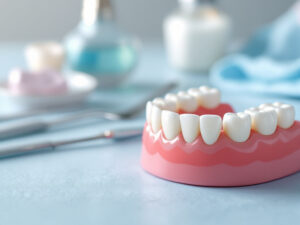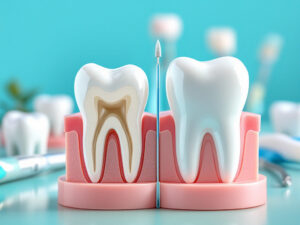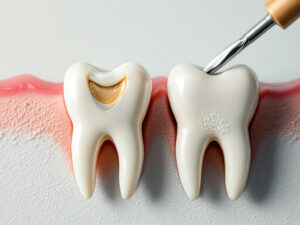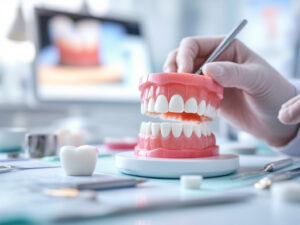Discover painless cavity filling
If you have ever felt anxious about dental visits and the possibility of pain, a painless cavity filling can change your perspective entirely. By combining advanced technology, modern materials, and compassionate care, it is now possible to treat tooth decay in a way that prioritizes your comfort. Whether you or a loved one is considering a cavity treatment for the first time, Cloninger Dentistry offers an approach focused on reducing anxiety and ensuring you leave with both a healthy smile and renewed peace of mind.
Addressing dental anxiety
Many people dread cavity fillings because of concerns about local anesthesia or the sound of a dental drill. These worries can feel overwhelming, particularly for those who have had unpleasant dental experiences in the past. At Cloninger Dentistry, the goal is to eliminate or minimize discomfort through techniques such as:
- Gentle local anesthesia that is carefully administered
- No-drill approaches with air abrasion or laser tools
- Sedation when appropriate, helping you relax before and during treatment
- Supportive, informative staff who address your concerns before starting any procedure
When you know that efficiency and comfort are top priorities, it is often easier to schedule needed care. Once your anxiety level goes down, you are far more likely to receive treatment that keeps your teeth healthy, strong, and attractive.
See how cavities form
Cavities develop when bacteria in your mouth break down food particles and produce acids that gradually eat away at tooth enamel. If left untreated, these weakened or decayed areas can progress until a filling is necessary. Regular visits to your dentist, including a routine dental checkup and professional teeth cleaning, can help detect signs of decay early and stop it from worsening.
The role of bacteria and acids
Bacteria thrive on sugars and starches from your diet, producing acids as a byproduct. Over time, these acids can break down the protective enamel layer of your teeth, causing tiny openings. Plaque and tartar build-up often accelerate this process. If you skip preventive hygiene, small issues can become larger ones, leading to more complicated treatments down the line.
Keeping the mouth clean and pH-balanced can make a significant difference. Brushing at least twice a day, flossing, and using antibacterial mouthwash help reduce harmful bacteria. A balanced diet, limited in sugary snacks and drinks, also plays a central role in preventing enamel erosion.
Review no-drill methods
Traditional drilling is not the only way to fill a cavity. Research and innovation have introduced several no-drill treatments that can make the process more comfortable and potentially eliminate the need for injections or numbing in mild or moderate cases.
Silver diamine fluoride
Silver diamine fluoride (SDF) is an effective, minimally invasive approach for controlling small cavities, especially for children or individuals with special needs (Brown Health). SDF is brushed right onto the decayed area to halt the progression of the infection. Here is what you should know about SDF:
- Spares healthy tooth structure, focusing only on the decayed part
- Darkens the area of decay to confirm progress, but you can mask the discoloration with a tooth-colored filling
- Provides antibacterial protection due to its silver content
- Offers fluoride to strengthen tooth structure
Because of the gentle nature of this approach, you often do not need an injection. For many, this is an excellent solution that encourages faster healing and less overall anxiety about the procedure.
Air abrasion and laser dentistry
Air abrasion uses a stream of tiny particles to remove decayed material without the heat or vibrations associated with drilling (Desert Lake Family Dentistry). This technique:
- Targets only the damaged tooth structure
- Preserves surrounding enamel
- Reduces the need for anesthesia
- Involves minimal noise and vibration
Laser dentistry is another advanced option. Focused light energy precisely removes decayed tissue and prepares the tooth for a filling (Arrow Dental Arts). This method can reduce bleeding, accelerate healing, and create a more comfortable experience. Not everyone’s cavity depth or tooth structure is suitable for laser treatment, so it is wise to consult your dentist about whether it is a good option for you.
Sedation and comfort measures
If you experience severe dental anxiety or a more extensive cavity, sedation dentistry can help. Numerous options exist, such as:
- Inhaled minimal sedation using nitrous oxide
- Oral sedation in pill form
- IV sedation for deeper relaxation
These measures let you rest comfortably and remain calm throughout the treatment. At Cloninger Dentistry, your safety and emotional well-being come first, so you can openly discuss sedation with your dental team to find the ideal approach.
Compare filling materials
Even if drilling is minimized or eliminated, the tooth still needs to be filled to restore its shape and strength. The type of filling best suited for your situation will depend on factors like cavity size, location, budget, and cosmetic needs. The most common options include amalgam, composite resin, gold, porcelain, and glass ionomer.
Below is a quick comparison:
| Material | Pros | Cons | Approx. Lifespan |
|---|---|---|---|
| Amalgam | Durable and cost-effective | Visible metallic color, contains mercury | 10–15 years (Cleveland Clinic) |
| Composite resin | Blends with natural tooth color | Shorter lifespan, may stain over time | ~7 years, depends on care |
| Porcelain | Very natural-looking, resists staining | Higher cost than some alternatives | Up to 15 years |
| Gold | Extremely durable and corrosion-resistant | Noticeable color, higher price | 20+ years, with proper care |
| Glass ionomer | Releases fluoride to help protect tooth | Not as durable as other options | 5–10 years |
Depending on your preferences and the location of the cavity, certain materials might be better. Composite resin is very popular for front teeth, as it matches tooth color, while gold or amalgam may be chosen for molars that endure heavy chewing forces.
Plan your recovery process
Once your filling is placed, it is normal to experience mild soreness or tooth sensitivity for a few days. According to the Cleveland Clinic, minor gum discomfort can also appear but typically resolves in one to two weeks (Cleveland Clinic). The healing process is simpler when the treatment requires minimal drilling or sedation since less trauma is inflicted on the tooth.
- Stick to soft foods for the first day if you still feel numb
- Avoid biting hard objects until the filling sets completely
- Use over-the-counter pain relievers if recommended by your dentist
- Report any severe or worsening pain promptly
With proper care, a new filling can protect your tooth and reduce the chance of further decay.
Safe follow-up care
Following your procedure, you may want to schedule a fluoride treatment or more frequent professional teeth cleaning visits. Fluoride applications add an extra layer of defense against future cavities, while cleanings help remove plaque and tartar that can accumulate around the edges of fillings.
If sensitivity persists, your dentist might recommend a tooth sensitivity treatment option or discuss whether your bite needs small adjustments to ensure the filling does not interfere with chewing. Staying proactive with follow-up appointments is the best way to enjoy long-lasting results and ensure your comfort is maintained.
Why choose Cloninger Dentistry
When it comes to comprehensive family dental care, Cloninger Dentistry takes pride in offering a warm, empathetic approach designed to keep you at ease. The team understands how daunting dental work can be, so they prioritize comfort without compromising on excellent clinical outcomes.
- Expertise for all ages: From preventive pediatric dental care to restorative procedures for older adults, Cloninger Dentistry can address the diverse concerns that arise in a family.
- State-of-the-art technology: Advanced diagnostic tools, such as digital xray imaging or intraoral camera examination, help detect decay and other issues before they become serious problems. In turn, that means more comfortable and efficient treatments for you.
- Wide range of services: Whether you need root canal therapy, porcelain crown service, or a simple tooth extraction, staff are trained to handle routine to complex treatments in a professional environment. If an emergency arises, emergency dental care is available to manage unexpected pain or trauma swiftly.
- Personalized experience: Each individual’s chew pattern, tooth structure, and medical history are unique. By tailoring treatments and making sedation options available, the practice ensures you do not have to suffer from discomfort or anxiety.
- Preventive philosophy: Long-term oral health is achieved by focusing on early detection and consistent care. From your initial new patient dental exam to ongoing checkups, Cloninger Dentistry ensures every patient is guided, educated, and supported in preserving a healthy smile.
Building a consistent relationship with a trusted provider means you will have a go-to place for everything, from scheduling a same day dental appointment when you suspect a problem to creating a personalized plan for your long-term oral health.
Prevention for long-term oral health
While a painless cavity filling addresses existing decay, putting preventive strategies in place can spare you future visits for restorative procedures. Maintaining a comprehensive oral hygiene routine is the first step:
- Brush your teeth at least twice a day.
- Floss once daily to remove food particles between teeth.
- Use mouthwash to reduce bacteria and freshen breath.
- Limit sugary snacks and drinks to reduce the acid production that leads to enamel erosion.
- Drink ample water to wash away food debris and keep saliva flow healthy.
Regular appointments for professional teeth cleaning and routine dental checkup will help track your progress and detect any potential issues early on. If your dentist suggests additional measures like sealants or fluoride applications, these can help defend against plaque buildup in hard-to-reach spots.
Beyond the basics, it is beneficial to practice healthy eating habits and mind your overall health. Smoking or using tobacco products can seriously affect both your oral and general well-being, thus increasing risks of tooth decay and gum disease. Clear communication with your dentist about any concerns or lifestyle habits helps tailor a unique plan just for you.
Frequently asked questions
1. Will a painless cavity filling really be pain-free?
Nothing is guaranteed to be 100 percent pain-free for every individual, but today’s techniques come incredibly close for most people. Thanks to local anesthesia, no-drill technology, and sedation options, discomfort is kept to a minimum. You are encouraged to talk with your dentist about your concerns before the procedure begins.
2. Is it safe for children to have no-drill fillings?
Yes, especially for smaller cavities. Approaches like silver diamine fluoride can help slow or stop the cavity’s progression in children who might struggle with traditional drilling due to anxiety or inability to sit still. Your dentist will evaluate the size and location of the cavity to recommend the most appropriate treatment.
3. What if I have a metal allergy?
If you are allergic to metals found in some fillings (such as mercury in amalgam), your dentist can explore alternative materials like composite resin, gold alloys (if you are not allergic to gold), porcelain, or glass ionomer. Be sure to mention any known allergies so that your filling type can be carefully selected.
4. Can I get a painless cavity filling if my decay is advanced?
More extensive decay may require deeper intervention and, in some cases, a crown or root canal therapy rather than a simple filling. Still, your dentist will employ sedation or other pain-management techniques to keep you as comfortable as possible. The goal is to save the natural tooth whenever feasible and proceed with gentler methods first.
5. How do I maintain my new filling long-term?
You should maintain an excellent oral hygiene routine to prolong the lifespan of your filling. This includes brushing, flossing, and scheduling regular follow-up appointments. Keep an eye on any sensitivity, discoloration, or changes around the filled tooth. If you notice any issues or persistent sensitivity, contact your dentist for recommended follow-up care.
Final thoughts
Investing in a painless cavity filling not only preserves your tooth but also protects your confidence in seeking dental care. By selecting a practice that offers a compassionate environment, advanced technology, and tailored options for every family member, you can address and prevent cavities without sacrificing comfort. Cloninger Dentistry is committed to delivering this level of service, providing expertise in everything from pediatric dental care to emergency dental care, and beyond.
Because healthy teeth and gums are linked to overall well-being, you deserve a provider who truly values your concerns and keeps your comfort at the forefront. By exploring no-drill techniques, selecting the right filling material, and focusing on regular preventive visits, you can enjoy a radiant smile that lasts for years. When it is time to schedule your next checkup or explore more advanced dental care, you or your loved ones can feel confident that Cloninger Dentistry stands ready to help. After all, it is your comfort, your health, and your happiness that matter most.










